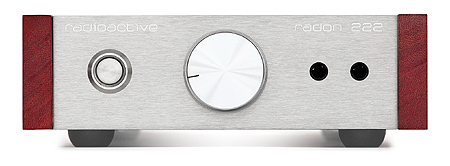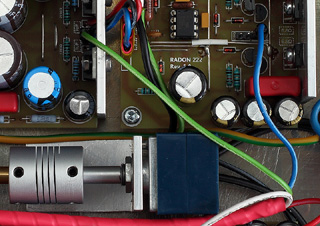In search for the perfect sound
Hi-End headphone amplifier Radon 222

After a year of work the
prototype of headphone amplifier finally turned into a full blown product and 3 pieces are available for first customers.
The
prototype that was show on the London Meet in 2013 undergone many modifications and changes. The most obvious is of course a professionally
made case with 8mm thick anodised front panel as well as top cover and back plate.
Other very important change is in the architecture design. Ultimate quality of sound does not allow for any compromises.
Only full dual mono designs can allow for proper grounding topology when Phono outputs are used.
This is because phono sockets share the ground connector for both left and right channels, so to avoid ground loops this has to be the only
common ground connections between channels. This implies there is no other common ground junctions such as at the shared power supply.
Ordering info
Hurry, only 2 units are available now!
To get more information on how to try it out and buy please follow to
this section.
Main features and improvements since prototype:
- Full Dual Mono architecture 2x8W (2x2.3W operating in pure class A).
- High band pass of the amplifier (>1MHz).
- Internal case copper shielding.
- Symmetry across all PCBs along with uncompromised ground paths topology which made possible decreasing the noise and power line hum to inaudible levels.
- Improved power supply and high class Murata SMD ceramic capacitors used to improve impulse response throughout the entire signal path.
- All connectors and relays used in a signal path are duplicated to decrease distortions and improve damping factor.
- Minimum load resistance 20Ω (output voltage p-to-p ±10V, THD <0.01%). Amplifier however works well also with much lower resistances.
- Harmonic distortions (THD) <0.0003%
- Intermodulation distortions (IMD) <0.0033%
Construction
There are two separate power supply modules, each providing positive and negative 15V stabilized by LM337 and LM317 chips.
Both are fed with the voltage smoothed out by 2 pole low pass filter based on electrolytic caps selected for best performance
in regards of internal serial resistance. They are supported by WIMA MKP capacitors as well as by Murata’s MMLC XR7 capacitors.
In one of the amplifier I have replaced stabilisers by LT1085 and LT1033 respectively to hear their impact on the
sound performance, however the changes are so subtle I am not sure if I would be able to distinguish
them in double blind test.

Audio section begins with the BLUE Alps 10kΩ potentiometer. Then attenuated signal goes to the OPA627BP(*) op amp,
which is regarded as one of the best for audio purposes available on the market
1.
It has exceptionally low noise and harmonic distortion levels and is used to drive complementary pair of bipolar transistors working in push-pull mode.
These are Hitachi SD669 and SB649, currently quite difficult to get, but their parameters such as similar gain levels
and wide frequency bandwidth (>100MHz) makes it perfect for output stages of headphone amplifiers.
* - Operational amplifier is exchangeable. Other available and tested options are: AD797 and LME49990.
The latter is a construction made by National Semiconductor which is especially worth consideration for excellent audio performance and specs.
I am of the opinion that only high band pass can faithfully amplify the audio signal produced by any
DAC output and keep the fastest transient response. This translates in a very tight control of headphone diaphragms
thus significantly improves detail resolution and bass response.
But high band pass makes the amplifier prone for picking up radio frequency noise which may interfere
with audible frequencies. To avoid this I had to resolve to several measures:
- Dual mono architecture and very careful ground paths planning.
- Zobel networks in inputs and outputs to reduce RF noise pickup of connected cables.2
- Internal connectors custom shielding (copper strips).
- Copper case shielding on wooden sides.
Although I used many protections there is still no ferrite beads used anywhere in the signal path as according to some experts
2
it may have undesired impact on the sonic performance of the amplifier.
I gave up adding input buffering stage from a simple reason, most of the audio sources do not afraid
of simple loads of around 10kΩ. This limited the number of active stages to a bare minimum
and the same the amount of unnecessary noises or distortions. OPA627BP has very good static specifications as well.
That includes output voltage offset. Total DC output voltage offset is less than 5mV for both channels.
Therefore there is no need to employ a DC servo circuit or separating capacitors which are
never neutral
for the sound quality.
Output impedance
Radon 222 amplifier is employed in a number of protection circuits, which are to limit losses in case
of catastrophic failures like output transistor short circuit. But most of all they are about to protect
usually expensive headphones. In any such cases headphones are quickly disconnected from the amplifier.
Additional circuit eliminates initial unpleasant spikes by delaying the moment of enabling headphone output
by a couple of seconds. Thanks to it, the moment of turning the amplifier on is practically inaudible.
The measured output impedance of the amplifier is around 50mΩ (for loads between 6-300 Ω) of which 30mΩ are caused by
internal connections, protection relays and Jack socket.
This corresponds to 0.5mΩ for 200W power amplifiers and that is a quite impressive result. Working on the prototype
taught me that there can be no compromise in regards of this parameter when it comes for the ultimate sound quality.
| Specifications: |
| Output power: | 2x8W |
| Output power (class A): | 2x2.3W |
| Number of inputs: | 1 (RCA) |
| Number of outputs: | 2 (Phono/Jack) |
| Maximum output load @THD<0.01%,±10V: | 20Ω |
| Input load: | 10kΩ |
| Output impedance (6Ω-300Ω) 20Hz-20kHz: | 0.051-0.058Ω (10%) |
| Harmonic distortions THD: | 0.0004-0.0018% (*) |
| Harmonic distortions & noise THD+N: | 0.0015-0.0061% (**) |
| Intermodulation distortions IMD: | <0.0033% |
| Protection circuits: | Shortcircuit protection and delayed output on. |
| Dimensions (W x H x D): | 198x56x334[mm] |
| Power consumption: | 9W |
* - Internal measurement card THD is 0.0014%
** - Internal measurement card THD+N is 0.0046%
Annotations
Radek Strugalski